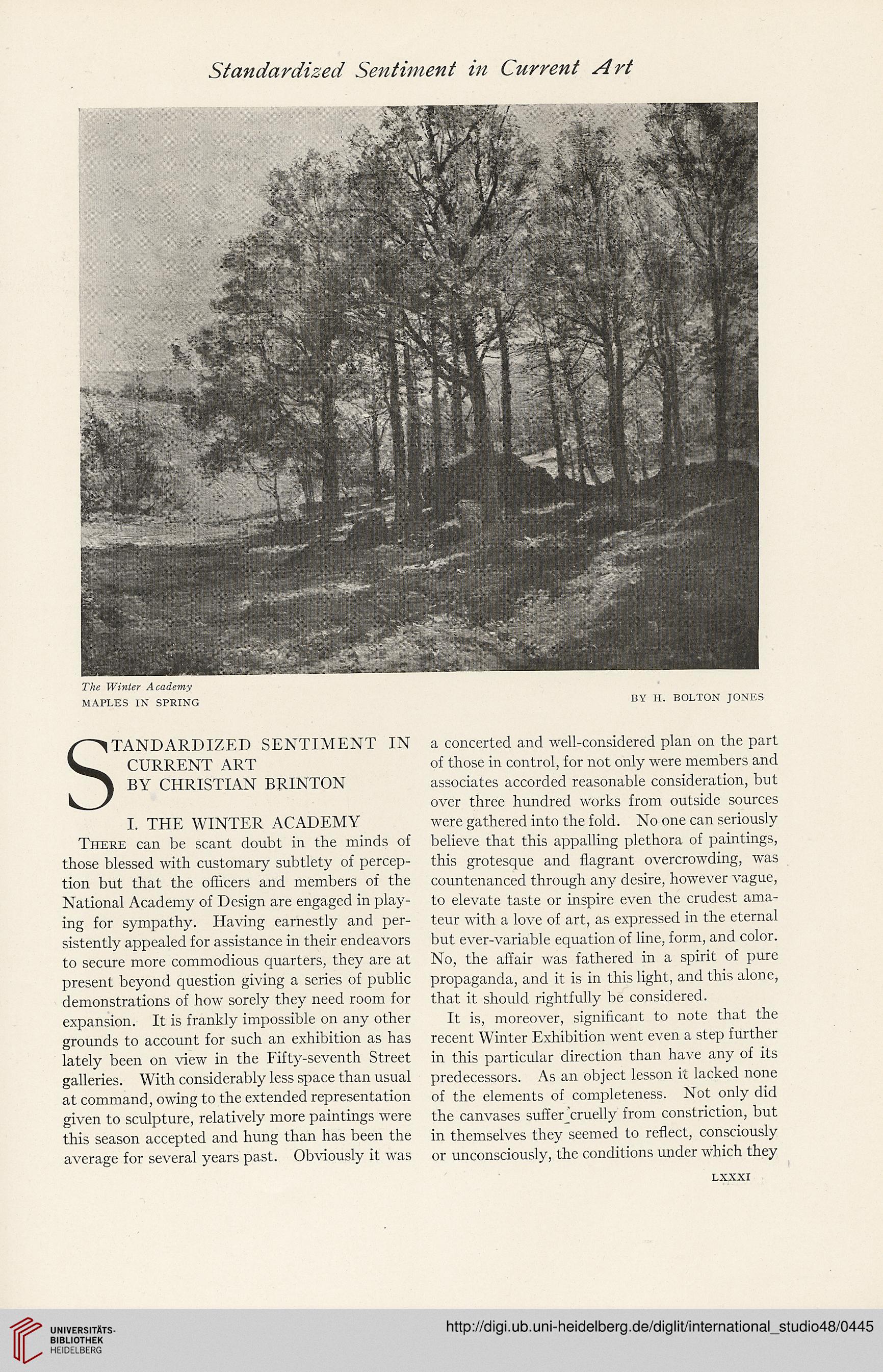Standardized Sentiment in Current Art
The Winter Academy
MAPLES IN SPRING BY H. BOLTON JONES
STANDARDIZED SENTIMENT IN
CURRENT ART
I BY CHRISTIAN BRINTON
I. THE WINTER ACADEMY
There can be scant doubt in the minds of
those blessed with customary subtlety of percep-
tion but that the officers and members of the
National Academy of Design are engaged in play-
ing for sympathy. Having earnestly and per-
sistently appealed for assistance in their endeavors
to secure more commodious quarters, they are at
present beyond question giving a series of public
demonstrations of how sorely they need room for
expansion. It is frankly impossible on any other
grounds to account for such an exhibition as has
lately been on view in the Fifty-seventh Street
galleries. With considerably less space than usual
at command, owing to the extended representation
given to sculpture, relatively more paintings were
this season accepted and hung than has been the
average for several years past. Obviously it was
a concerted and well-considered plan on the part
of those in control, for not only were members and
associates accorded reasonable consideration, but
over three hundred works from outside sources
were gathered into the fold. No one can seriously
believe that this appalling plethora of paintings,
this grotesque and flagrant overcrowding, was
countenanced through any desire, however vague,
to elevate taste or inspire even the crudest ama-
teur with a love of art, as expressed in the eternal
but ever-variable equation of line, form, and color.
No, the affair was fathered in a spirit of pure
propaganda, and it is in this light, and this alone,
that it should rightfully be considered.
It is, moreover, significant to note that the
recent Winter Exhibition went even a step further
in this particular direction than have any of its
predecessors. As an object lesson it lacked none
of the elements of completeness. Not only did
the canvases sufferJcruelly from constriction, but
in themselves they seemed to reflect, consciously
or unconsciously, the conditions under which they
LXXXI
The Winter Academy
MAPLES IN SPRING BY H. BOLTON JONES
STANDARDIZED SENTIMENT IN
CURRENT ART
I BY CHRISTIAN BRINTON
I. THE WINTER ACADEMY
There can be scant doubt in the minds of
those blessed with customary subtlety of percep-
tion but that the officers and members of the
National Academy of Design are engaged in play-
ing for sympathy. Having earnestly and per-
sistently appealed for assistance in their endeavors
to secure more commodious quarters, they are at
present beyond question giving a series of public
demonstrations of how sorely they need room for
expansion. It is frankly impossible on any other
grounds to account for such an exhibition as has
lately been on view in the Fifty-seventh Street
galleries. With considerably less space than usual
at command, owing to the extended representation
given to sculpture, relatively more paintings were
this season accepted and hung than has been the
average for several years past. Obviously it was
a concerted and well-considered plan on the part
of those in control, for not only were members and
associates accorded reasonable consideration, but
over three hundred works from outside sources
were gathered into the fold. No one can seriously
believe that this appalling plethora of paintings,
this grotesque and flagrant overcrowding, was
countenanced through any desire, however vague,
to elevate taste or inspire even the crudest ama-
teur with a love of art, as expressed in the eternal
but ever-variable equation of line, form, and color.
No, the affair was fathered in a spirit of pure
propaganda, and it is in this light, and this alone,
that it should rightfully be considered.
It is, moreover, significant to note that the
recent Winter Exhibition went even a step further
in this particular direction than have any of its
predecessors. As an object lesson it lacked none
of the elements of completeness. Not only did
the canvases sufferJcruelly from constriction, but
in themselves they seemed to reflect, consciously
or unconsciously, the conditions under which they
LXXXI





